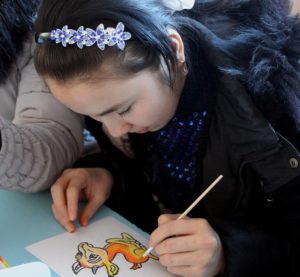A diversity of representatives of the animal world regularly embark on risky and exhausting travels just to survive as a species. So many dangers and obstacles are encountered by migratory animals on their way. And many of them have been created artificially, by human hands. The saiga is a champion long-distance migrant.  An ecological festival dedicated to Migratory Animals Day was held in the schools of Nukus and Ustyurt in October 2014. The festival was preceded by preparatory work during which children from the Steppe Wildlife Clubs made informative posters showing the lengthy migrations undertaken by such champion animals as marine turtles, whales, monarch butterflies and of course, saigas, Bukhara deer and snow leopards.
An ecological festival dedicated to Migratory Animals Day was held in the schools of Nukus and Ustyurt in October 2014. The festival was preceded by preparatory work during which children from the Steppe Wildlife Clubs made informative posters showing the lengthy migrations undertaken by such champion animals as marine turtles, whales, monarch butterflies and of course, saigas, Bukhara deer and snow leopards.
Children also chose their favourite characters from the kingdom of migratory animals and made masks representing them. The young ecologists, assisted by educators and the club head, then found out about their characters and started rehearsing their mini-performance. Early in the morning the next day, everyone who entered the school saw a poster with pictures and interesting facts about the life of migratory animals. Senior students from the Steppe Wildlife Club, dressed as a Saiga King or Queen, came to visit small children from the primary school and gave then a short performance about migratory animals.
 Until quite recently, the saigas of the Ustyurt Plateau would make one of the lengthiest of the saiga’s seasonal migrations. In autumn the animals came from the steppes of Kazakhstan to the winter pastures of Uzbekistan, and in spring they returned north to the steppes of Kazakhstan. Snow leopards follow their prey, mountain goats, through the steep mountains, crossing the borders of Kygyzstan, Tajikistan, Uzbekistan and Kazakhstan. Bukhara deer travel from one bank of the Amu Darya River to another, from Uzbekistan to Turkmenistan and back. What makes these animals tick? What makes them start on such lengthy travels, often at risk of their lives? Animal migrations are caused by changes in their living conditions. Shortage of forage, low temperatures, a search for favourable breeding grounds and other reasons make animals cover many kilometres by air, land or water. An ecological festival dedicated to Migratory Animals Day was held in the schools of Nukus and Ustyurt in October 2014.
Until quite recently, the saigas of the Ustyurt Plateau would make one of the lengthiest of the saiga’s seasonal migrations. In autumn the animals came from the steppes of Kazakhstan to the winter pastures of Uzbekistan, and in spring they returned north to the steppes of Kazakhstan. Snow leopards follow their prey, mountain goats, through the steep mountains, crossing the borders of Kygyzstan, Tajikistan, Uzbekistan and Kazakhstan. Bukhara deer travel from one bank of the Amu Darya River to another, from Uzbekistan to Turkmenistan and back. What makes these animals tick? What makes them start on such lengthy travels, often at risk of their lives? Animal migrations are caused by changes in their living conditions. Shortage of forage, low temperatures, a search for favourable breeding grounds and other reasons make animals cover many kilometres by air, land or water. An ecological festival dedicated to Migratory Animals Day was held in the schools of Nukus and Ustyurt in October 2014.
The festival was preceded by preparatory work during which children from the Steppe Wildlife Clubs made informative posters showing the lengthy migrations undertaken by such champion animals as marine turtles, whales, monarch butterflies and of course, saigas, Bukhara deer and snow leopards. Children also chose their favourite characters from the kingdom of migratory animals and made masks representing them. The young ecologists, assisted by educators and the club head, then found out about their characters and started rehearsing their mini-performance.
 Early in the morning the next day, everyone who entered the school saw a poster with pictures and interesting facts about the life of migratory animals. Senior students from the Steppe Wildlife Club, dressed as a Saiga King or Queen, came to visit small children from the primary school and gave then a short performance about migratory animals. Because you remember better when you teach others, we chose to use this “peer-to-peer” learning approach. After the visit of these unusual guests to the primary school, a second wave of curiosity arises, but now it is more conscious. Now a queue forms to look at the information poster. For a long time, children kept discussing this new information, which was presented in such an unusual way.
Early in the morning the next day, everyone who entered the school saw a poster with pictures and interesting facts about the life of migratory animals. Senior students from the Steppe Wildlife Club, dressed as a Saiga King or Queen, came to visit small children from the primary school and gave then a short performance about migratory animals. Because you remember better when you teach others, we chose to use this “peer-to-peer” learning approach. After the visit of these unusual guests to the primary school, a second wave of curiosity arises, but now it is more conscious. Now a queue forms to look at the information poster. For a long time, children kept discussing this new information, which was presented in such an unusual way.
They were astonished and delighted. They learned about the difficulties which these living beings had to overcome in their struggle for survival. It seemed that Nature itself came to visit them and became closer and more understandable.
